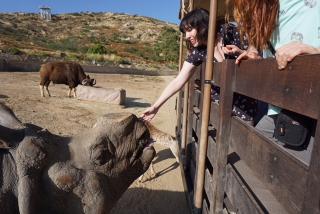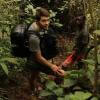With new technologies revolutionizing data collection, wildlife researchers are becoming increasingly able to collect data at much higher volumes than ever before. Now we are facing the challenges of putting this information to use, bringing the science of big data into the conservation arena. With the help of machine learning tools, this area holds immense potential for conservation practices. The applications range from online trafficking alerts to species-specific early warning systems to efficient movement and biodiversity monitoring and beyond.
However, the process of building effective machine learning tools depends upon large amounts of standardized training data, and conservationists currently lack an established system for standardization. How to best develop such a system and incentivize data sharing are questions at the forefront of this work. There are currently multiple AI-based conservation initiatives, including Wildlife Insights and WildBook, that are pioneering applications on this front.
This group is the perfect place to ask all your AI-related questions, no matter your skill level or previous familiarity! You'll find resources, meet other members with similar questions and experts who can answer them, and engage in exciting collaborative opportunities together.
Just getting started with AI in conservation? Check out our introduction tutorial, How Do I Train My First Machine Learning Model? with Daniel Situnayake, and our Virtual Meetup on Big Data. If you're coming from the more technical side of AI/ML, Sara Beery runs an AI for Conservation slack channel that might be of interest. Message her for an invite.
Header Image: Dr Claire Burke / @CBurkeSci

Explore the Basics: AI
Understanding the possibilities for incorporating new technology into your work can feel overwhelming. With so many tools available, so many resources to keep up with, and so many innovative projects happening around the world and in our community, it's easy to lose sight of how and why these new technologies matter, and how they can be practically applied to your projects.
Machine learning has huge potential in conservation tech, and its applications are growing every day! But the tradeoff of that potential is a big learning curve - or so it seems to those starting out with this powerful tool!
To help you explore the potential of AI (and prepare for some of our upcoming AI-themed events!), we've compiled simple, key resources, conversations, and videos to highlight the possibilities:
Three Resources for Beginners:
- Everything I know about Machine Learning and Camera Traps, Dan Morris | Resource library, camera traps, machine learning
- Using Computer Vision to Protect Endangered Species, Kasim Rafiq | Machine learning, data analysis, big cats
- Resource: WildID | WildID
Three Forum Threads for Beginners:
- I made an open-source tool to help you sort camera trap images | Petar Gyurov, Camera Traps
- Batch / Automated Cloud Processing | Chris Nicolas, Acoustic Monitoring
- Looking for help with camera trapping for Jaguars: Software for species ID and database building | Carmina Gutierrez, AI for Conservation
Three Tutorials for Beginners:
- How do I get started using machine learning for my camera traps? | Sara Beery, Tech Tutors
- How do I train my first machine learning model? | Daniel Situnayake, Tech Tutors
- Big Data in Conservation | Dave Thau, Dan Morris, Sarah Davidson, Virtual Meetups
Want to know more about AI, or have your specific machine learning questions answered by experts in the WILDLABS community? Make sure you join the conversation in our AI for Conservation group!
Join the Seeed Vision Challenge, an opportunity for conservation innovators to harness the power of AI vision sensors for environmental monitoring and protection.
10 April 2024
Full-Stack Software Developer (Python/React) - Specializing in AI/ML for Wildlife Conservation
5 April 2024
Article
Article from Ars Technica about how difficult it is to detect and avoid kangaroos...
3 April 2024
18 month postdoc research position, Netherlands, EU-funded
28 March 2024
Article
You’re invited to the WILDLABS Variety Hour, a monthly event that connects you to conservation tech's most exciting projects, research, and ideas. We can't wait to bring you a whole new season of speakers and...
22 March 2024
Join our multi-national team at the AI for Biodiversity Change Global Climate Center! We're hiring a Research Data Manager & Tech Coordinator at Ohio State. Support cutting-edge research on climate change &...
15 March 2024
Catch up on the conservation tech discussions and events that happened during World Wildlife Day 2024!
7 March 2024
EcoAssist introduces a free African species identification model for camera trap images, capable of recognising 30 species.
5 March 2024
Join us to help prevent biodiversity loss! Understory is hiring a postdoc to lead R&D Development on generalizing Computer Vision models for vegetation identification across space/time/phenotypes.
29 February 2024
Join the Luxembourg Institute of Science and Technology (LIST) in pioneering environmental and ecological monitoring! 🌍💡 As part of ERIN’s Observatory for Climate, Environment, and Biodiversity (OCEB), you'll be at the...
26 February 2024
SNTech are recruiting for 3 roles to assist us to develop computer vision pipelines for underwater monitoring
15 February 2024
We invite applications for the third Computer Vision for Ecology (CV4E) workshop, a three-week hands-on intensive course in CV targeted at graduate students, postdocs, early faculty, and junior researchers in Ecology...
12 February 2024
April 2024
event
event
October 2024
August 2023
event
event
event
June 2023
event
Senior Conservation Technology Expert Position (Consultancy) with the Global Wildlife Program
22 September 2022 5:35pm
Catch Up with the Variety Hour: October 2022
22 September 2022 1:59pm
WIA After Hours: Episode #5 - AI for Wildlife Conservation and Imageomics with Dr. Tanya Berger-Wolf
21 September 2022 6:53pm
Listen to Tanya Berger-Wolf's conversation about AI for Wildlife Conservation and imageomics with Lauren Burke on the Women In Analytics After Hours Podcast.
Amazon Sustainability call for proposals — Fall 2022
20 September 2022 11:37am
Google.org commitment on using AI to accelerate progress on global development goals
16 September 2022 6:31pm
Research Software Engineer, Climate & Sustainability, IBM
16 September 2022 2:18pm
CamTrap Ecology meets AI conference
14 September 2022 4:47pm
Join the BirdNET team!
9 September 2022 2:43pm
Postdoc: Interpretable ML for species-based image classification
1 September 2022 9:34pm
New paper - 'soundClass: An automatic sound classification tool for biodiversity monitoring using machine learning'
1 September 2022 8:53pm
Silva et al -
- R package to train convolutional neural networks & employ them to classify sounds
- sound event classification pipeline, from annotating recordings to automating
trained networks
- case studies with bat & whale echolocation calls, bird songs
Introducing G.AI.A: Artificial Intelligence and Planetary-Scale Environmental Management
31 August 2022 10:25pm
Mara Predators Hackathon
30 August 2022 1:28pm
Research Associate in Conservation Ecology at QUT
29 August 2022 2:54pm
Conservation Technology Research Internship
26 August 2022 4:58pm
Postdoc in the application of AI for wildlife conservation & management
26 August 2022 11:47am
Online Hackathon: Predators conservation in the Maasai Mara
22 August 2022 10:32am
Ceres Wild Rhino application
22 August 2022 1:29am
Lead Software Engineer for ARISE
19 August 2022 8:22am
Lead Software Engineer, Wildlife Insights
10 August 2022 11:06pm
Research Technician - Unoccupied Aircraft Systems Pilot and Geospatial Analyst
10 August 2022 10:40pm
Building a simple AI-powered, human-in-the-loop system to manage wildlife camera trap images & annotations
10 August 2022 8:12pm
Hi folks! I built out a human-in-the-loop annotation platform for Felidae Conservation Fund, a SF-Bay Area nonprofit last Fall using MegaDetector. I'm looking for feedback from this amazing community around areas of collaboration, especially data/software resources we can share!
3yr Postdoctoral Associate: Remote Sensing and Unoccupied Aircraft Systems
10 August 2022 5:29pm
Catch Up with the WILDLABS Variety Hour: August 2022
10 August 2022 11:44am
Technology may solve climate change problems, but it’s also causing them | VentureBeat
8 August 2022 11:26am
Interesting thought piece from Mark Minevitch (AI for Good) et al. on the promise of AI and other ICT innovation to deliver on climate challenges, existing ICT sector emissions - and the three types of carbon lock-in which need to be actively managed (behavioural, digital, infrastructure).
'The danger is that the promises of digital technology can blind us to its less-recognized contributions to climate woes. Emissions from the ICT sector already rival those of the airline industry. Moreover, the few studies done so far (a,b,c) suggest the ICT sector’s emissions will at least double to 2-3 GTCO2e and if the rise in global GHG emissions is limited to 1.5˚C by 2030, contribute approximately 10% of the global GHG burden — nearly equal to that of the automotive industry. And these are cautious estimates.'
Can deep learning identify seabirds? (species, within-species, individual)
25 May 2022 8:24pm
21 June 2022 4:55pm
Update: I asked the same question on twitter so I'm sharing answers I got there:
With quality photos and good labeled training data, I would say definitely doable! @ultralytics and their #YOLOv5 models would be a cool place to start!
— Abram B. Fleishman (@abfleishman) May 26, 2022
Let's chat! We've been training models to run on trail cameras as images/videos are captured, and have worked on migratory birds along coastlines (more info: https://t.co/NzW4GO2Wqp)
— Henrik Cox (@henrik_cox) June 1, 2022
Have a look at this paper:https://t.co/pmvrmvJAuS
— Damien R. Farine (@DamienFarine) May 27, 2022
Individual identification needs tens of pictures per individual of known individuals as training data, which will be the challenge here.
Absolutely feasible, to learn how to train a CNN to identify species from satellite images I did a few tutorials on ID species from photographs. With the right training dataset it should be fairly straightforward. For individuals? Easier on species with clear markers (fins).
— Samanta's Wildlife (@SamantaWildlife) May 27, 2022
21 June 2022 5:41pm
Hi Yvan,
I dropped this into the AI for Conservation slack group as well, you got this reply this morning:

Steph
8 August 2022 11:12am
Hi Yvan,
If you find something which reaches your expectation and especially the ability to identify individual with plumage patterns I will be intereted.
In the same idea that Ultralytics, there is :
Which could probably answer your first and second requirements.
And find here a great website showing all the IA-based camera software, you may find solutions or contact throw this list:
Tiger, Tiger, in the Night... Now Visible in Real Time
5 August 2022 4:07pm
What is embedded ML, anyway?
 Edge Impulse
Edge Impulse
5 August 2022 3:48pm
Biological Data Science Summer Workshop
5 August 2022 3:03pm



























29 September 2022 4:05am